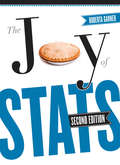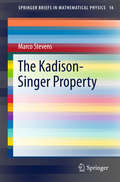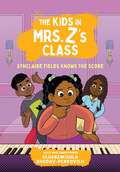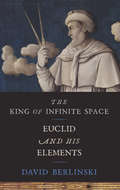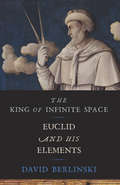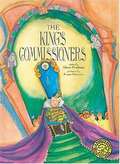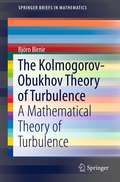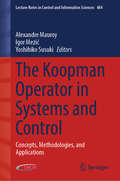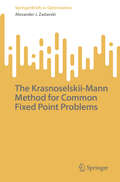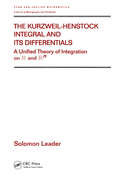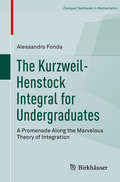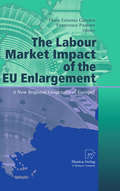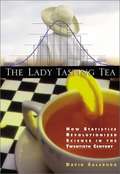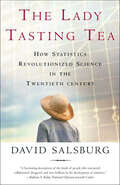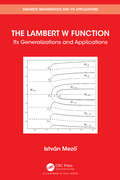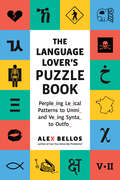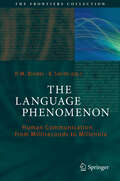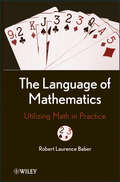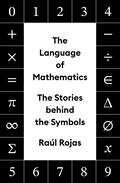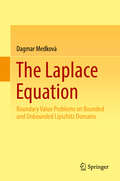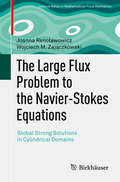- Table View
- List View
The Joy of Stats: A Short Guide To Introductory Statistics In The Social Sciences
by Roberta GarnerAs a stand-alone text, a self-study manual, or a supplement to a lab manual or comprehensive text, The Joy of Stats is a unique and versatile resource. A "Math Refresher" section and self-assessment test offer a concise review of the needed math background. A "How-To?" section provides short, handy summaries of data analysis techniques and explains when to apply them. Each chapter offers key terms, numerous examples—including real-world data—practice exercises and answers, and verbal algorithms as well as formulas. The result is an unrivalled guide for students of social science as well as for practitioners and policy-makers. The second edition has been revised throughout and includes many new examples. A new companion website, garnerjoyofstats.com, features a data set covering close to 120 countries and 10 variables, student exercises, and a full suite of instructor support materials, including power points for lectures, lab guides, and a test bank. For more information visit www.garnerjoyofstats.com.
The Joy of x: A Guided Tour of Math, from One to Infinity
by Steven Strogatz"Delightful . . . easily digestible chapters include plenty of helpful examples and illustrations. You'll never forget the Pythagorean theorem again!"--Scientific AmericanMany people take math in high school and promptly forget much of it. But math plays a part in all of our lives all of the time, whether we know it or not. In The Joy of x, Steven Strogatz expands on his hit New York Times series to explain the big ideas of math gently and clearly, with wit, insight, and brilliant illustrations.Whether he is illuminating how often you should flip your mattress to get the maximum lifespan from it, explaining just how Google searches the internet, or determining how many people you should date before settling down, Strogatz shows how math connects to every aspect of life. Discussing pop culture, medicine, law, philosophy, art, and business, Strogatz is the math teacher you wish you'd had. Whether you aced integral calculus or aren't sure what an integer is, you'll find profound wisdom and persistent delight in The Joy of x.
The Kadison-Singer Property
by Marco StevensThis book gives a complete classification of all algebras with the Kadison-Singer property, when restricting to separable Hilbert spaces. The Kadison-Singer property deals with the following question: given a Hilbert space H and an abelian unital C*-subalgebra A of B(H), does every pure state on A extend uniquely to a pure state on B(H)? This question has deep connections to fundamental aspects of quantum physics, as is explained in the foreword by Klaas Landsman. The book starts with an accessible introduction to the concept of states and continues with a detailed proof of the classification of maximal Abelian von Neumann algebras, a very explicit construction of the Stone-Cech compactification and an account of the recent proof of the Kadison-Singer problem. At the end accessible appendices provide the necessary background material. This elementary account of the Kadison-Singer conjecture is very well-suited for graduate students interested in operator algebras and states, researchers who are non-specialists of the field, and/or interested in fundamental quantum physics.
The Kids in Mrs. Z's Class: Synclaire Fields Knows the Score (The Kids in Mrs. Z's Class)
by Olugbemisola Rhuday-PerkovichMeet the kids in Mrs. Z&’s wacky and wonderful third-grade class! Synclaire Fields is proud to be the best in the class at math—until one mistake in a high-stakes situation means she's NOT the best after all. So who is she instead? Synclaire Fields is the Math Kid in Mrs. Z's class, getting perfect marks on every quiz and helping her classmates master tricky concepts. She especially loves demonstrating her skills at her parents' store after school. Then she gets TWO ANSWERS WRONG on a math test, and ... How can she be the Math Kid if she isn't good at math anymore? So Synclaire embarks on a quest to figure out what's next. Maybe she'll be a piano prodigy? A board-games whiz? A skating star? She likes some of these hobbies, but there's one constant with every role: She seems to come back to math. Maybe, with the help of her friends in Mrs. Z's class, she can still be the Math Kid after all? Both sweetly poignant and laugh-out-loud funny, with black-and-white illustrations by Pura Belpré Honor artist Kat Fajardo, Synclaire's story invites readers into Mrs. Z&’s class where friendship and fun rule the school, from NAACP Image Award finalist Olugbemisola Rhuday-Perkovich. Perfect for!★ My Weirdtastic School fans★ Reluctant readers★ Classroom read-alouds★ Andrew Clements fans★ Math whiz kids★ Math haters★ Kids who haven't found their hobby yet! Read them all! The Kids in Mrs. Z&’s Class have plenty of stories to share! Emma McKenna, Full out (#1) Rohan Murthy Has a Plan (#2) Poppy Song Bakes a Way (#3) The Legend of Memo Castillo (#4) Wyatt Hill Brings a Lizard to School (#5) Ayana Ndoum Takes the Stage (#6) Olive Little Gets Crafty (#7) — available for preorder now! Theo Chang is Not a Cat (#9) — available for preorder now! Thunder Nelson Does the Impossumble (#10) — available for preorder now! *The Kids in Mrs. Z&’s Class is an innovative series where every book is written by a different all-star author and features a different kid in the same third-grade class. They can be read in any order!
The King of Infinite Space
by David BerlinskiGeometry defines the world around us, helping us make sense of everything from architecture to military science to fashion. And for over two thousand years, geometry has been equated with EuclidOCOs "Elements," arguably the most influential book in the history of mathematics In "The King of Infinite Space," renowned mathematics writer David Berlinski provides a concise homage to this elusive mathematician and his staggering achievements. Berlinski shows that, for centuries, scientists and thinkers from Copernicus to Newton to Einstein have relied on EuclidOCOs axiomatic system, a method of proof still taught in classrooms around the world. EuclidOCOs use of elemental logicOCoand the mathematical statements he and others built from itOCohave dramatically expanded the frontiers of human knowledge. "The King of Infinite Space" presents a rich, accessible treatment of Euclid and his beautifully simple geometric system, which continues to shape the way we see the world. "
The King of Infinite Space: Euclid and His Elements
by David BerlinskiGeometry defines the world around us, helping us make sense of everything from architecture to military science to fashion. And for over two thousand years, geometry has been equated with Euclid’s Elements, arguably the most influential book in the history of mathematics In The King of Infinite Space, renowned mathematics writer David Berlinski provides a concise homage to this elusive mathematician and his staggering achievements. Berlinski shows that, for centuries, scientists and thinkers from Copernicus to Newton to Einstein have relied on Euclid’s axiomatic system, a method of proof still taught in classrooms around the world. Euclid’s use of elemental logic—and the mathematical statements he and others built from it—have dramatically expanded the frontiers of human knowledge. The King of Infinite Space presents a rich, accessible treatment of Euclid and his beautifully simple geometric system, which continues to shape the way we see the world.
The Kings Commissioners (A Marilyn Burns Brainy Day Book)
by Aileen FriedmanA delightful beginning for those learning the concepts of counting, addition, and the place value system encourages children to have fun while learning important math skills. <P><P>Lexile Measure: 630L
The Kolmogorov-Obukhov Theory of Turbulence
by Bjorn BirnirTurbulence is a major problem facing modern societies. It makes airline passengers return to their seats and fasten their seatbelts but it also creates drag on the aircraft that causes it to use more fuel and create more pollution. The same applies to cars, ships and the space shuttle. The mathematical theory of turbulence has been an unsolved problems for 500 years and the development of the statistical theory of the Navier-Stokes equations describes turbulent flow has been an open problem. The Kolmogorov-Obukhov Theory of Turbulence develops a statistical theory of turbulence from the stochastic Navier-Stokes equation and the physical theory, that was proposed by Kolmogorov and Obukhov in 1941. The statistical theory of turbulence shows that the noise in developed turbulence is a general form which can be used to present a mathematical model for the stochastic Navier-Stokes equation. The statistical theory of the stochastic Navier-Stokes equation is developed in a pedagogical manner and shown to imply the Kolmogorov-Obukhov statistical theory. This book looks at a new mathematical theory in turbulence which may lead to many new developments in vorticity and Lagrangian turbulence. But even more importantly it may produce a systematic way of improving direct Navier-Stokes simulations and lead to a major jump in the technology both preventing and utilizing turbulence.
The Koopman Operator in Systems and Control: Concepts, Methodologies, and Applications (Lecture Notes in Control and Information Sciences #484)
by Yoshihiko Susuki Alexandre Mauroy Igor MezićThis book provides a broad overview of state-of-the-art research at the intersection of the Koopman operator theory and control theory. It also reviews novel theoretical results obtained and efficient numerical methods developed within the framework of Koopman operator theory.The contributions discuss the latest findings and techniques in several areas of control theory, including model predictive control, optimal control, observer design, systems identification and structural analysis of controlled systems, addressing both theoretical and numerical aspects and presenting open research directions, as well as detailed numerical schemes and data-driven methods. Each contribution addresses a specific problem. After a brief introduction of the Koopman operator framework, including basic notions and definitions, the book explores numerical methods, such as the dynamic mode decomposition (DMD) algorithm and Arnoldi-based methods, which are used to represent the operator in a finite-dimensional basis and to compute its spectral properties from data. The main body of the book is divided into three parts:theoretical results and numerical techniques for observer design, synthesis analysis, stability analysis, parameter estimation, and identification;data-driven techniques based on DMD, which extract the spectral properties of the Koopman operator from data for the structural analysis of controlled systems; andKoopman operator techniques with specific applications in systems and control, which range from heat transfer analysis to robot control.A useful reference resource on the Koopman operator theory for control theorists and practitioners, the book is also of interest to graduate students, researchers, and engineers looking for an introduction to a novel and comprehensive approach to systems and control, from pure theory to data-driven methods.
The Krasnosel'skiĭ-Mann Iterative Method: Recent Progress and Applications (SpringerBriefs in Optimization)
by Panos M. Pardalos Yeol Je Cho Themistocles M. Rassias Qiao-Li Dong Songnian HeThis brief explores the Krasnosel'skiĭ-Man (KM) iterative method, which has been extensively employed to find fixed points of nonlinear methods.
The Krasnoselskii-Mann Method for Common Fixed Point Problems (SpringerBriefs in Optimization)
by Alexander J. ZaslavskiThis book delves into the intricate world of fixed point theory, focusing on the Krasnoselskii-Mann method to tackle common fixed point problems within a finite family of quasi-nonexpansive mappings in hyperbolic metric spaces. By exploring various iterative algorithms, including the Cimmino algorithm and dynamic string-averaging methods, this volume offers a comprehensive study of convergence and approximate solutions amidst computational errors. Key concepts such as W-hyperbolic spaces, convex combinations, and set-valued inclusions are meticulously examined. The author presents a detailed analysis of iterative methods, highlighting their effectiveness in solving complex fixed-point problems. Readers will encounter critical discussions on the behavior of exact and inexact iterates, the role of computational errors, and innovative approaches like remotest set control. This book invites readers to engage with challenging questions about convergence and solution accuracy in mathematical spaces. Ideal for researchers and scholars in mathematics and related fields, this book provides valuable insights into advanced iterative methods for solving fixed-point problems. Whether you are a mathematician specializing in nonlinear analysis or an academic exploring optimization theory, this volume is an essential resource for understanding the latest developments in fixed point theory.
The Kurzweil-Henstock Integral and Its Differential: A Unified Theory of Integration on R and Rn
by Solomon LeaderA comprehensive review of the Kurzweil-Henstock integration process on the real line and in higher dimensions. It seeks to provide a unified theory of integration that highlights Riemann-Stieljes and Lebesgue integrals as well as integrals of elementary calculus. The author presents practical applications of the definitions and theorems in each sec
The Kurzweil-Henstock Integral for Undergraduates: A Promenade Along the Marvelous Theory of Integration (Compact Textbooks in Mathematics)
by Alessandro FondaThis beginners' course provides students with a general and sufficiently easy to grasp theory of the Kurzweil-Henstock integral. The integral is indeed more general than Lebesgue's in RN, but its construction is rather simple, since it makes use of Riemann sums which, being geometrically viewable, are more easy to be understood. The theory is developed also for functions of several variables, and for differential forms, as well, finally leading to the celebrated Stokes–Cartan formula. In the appendices, differential calculus in RN is reviewed, with the theory of differentiable manifolds. Also, the Banach–Tarski paradox is presented here, with a complete proof, a rather peculiar argument for this type of monographs.
The Labour Market Impact of the EU Enlargement
by Francesco Pastore Floro Ernesto CaroleoUntil recently, regional labour market imbalances were considered transitory phenomena caused by state failure in yielding distorted investment incentives and by labour market rigidities. Labour mobility and wage flexibility were at the core of the debate over the causes of and cures for regional imbalances. This book bears witness to the changed perspective of research. For instance, in the recent literature, internal migration is depicted as a cause of further geographical divergence. The book contributes to the debate by presenting important new findings on: a) the reasons why structural change in some sectors causes a slump in some regions; b) the extent to which poverty traps explain spatial imbalances; c) the degree of convergence across EU countries and regions; d) the role of labour mobility in Central and Eastern Europe; e) and the role of pro-active employment schemes and child care facilities in alleviating the hardship of the weakest segments of the population.
The Lady Tasting Tea: How Statistics Revolutionized Science in the Twentieth Century
by David SalsburgThis author brilliantly relates the history of statistics with colorful stories and intriguing details concerning the pioneers in the field.
The Lady Tasting Tea: How Statistics Revolutionized Science in the Twentieth Century
by David SalsburgAn insightful, revealing history of the magical mathematics that transformed our world. The Lady Tasting Tea is not a book of dry facts and figures, but the history of great individuals who dared to look at the world in a new way. At a summer tea party in Cambridge, England, a guest states that tea poured into milk tastes different from milk poured into tea. Her notion is shouted down by the scientific minds of the group. But one man, Ronald Fisher, proposes to scientifically test the hypothesis. There is no better person to conduct such an experiment, for Fisher is a pioneer in the field of statistics. The Lady Tasting Tea spotlights not only Fisher's theories but also the revolutionary ideas of dozens of men and women which affect our modern everyday lives. Writing with verve and wit, David Salsburg traces breakthroughs ranging from the rise and fall of Karl Pearson's theories to the methods of quality control that rebuilt postwar Japan's economy, including a pivotal early study on the capacity of a small beer cask at the Guinness brewing factory. Brimming with intriguing tidbits and colorful characters, The Lady Tasting Tea salutes the spirit of those who dared to look at the world in a new way.
The Lambert W Function: Its Generalizations and Applications (Discrete Mathematics and Its Applications)
by Istvan MezoThis book is the very first one in the English language entirely dedicated to the Lambert W function, its generalizations, and its applications. One goal is to promote future research on the topic. The book contains all the information one needs when trying to find a result. The most important formulas and results are framed. The Lambert W function is a multi-valued inverse function with plenty of applications in areas like molecular physics, relativity theory, fuel consumption models, plasma physics, analysis of epidemics, bacterial growth models, delay differential equations, fluid mechanics, game theory, statistics, study of magnetic materials, and so on. The first part of the book gives a full treatise of the W function from theoretical point of view. The second part presents generalizations of this function which have been introduced by the need of applications where the classical W function is insufficient. The third part presents a large number of applications from physics, biology, game theory, bacterial cell growth models, and so on. The second part presents the generalized Lambert functions based on the tools we had developed in the first part. In the third part familiarity with Newtonian physics will be useful. The text is written to be accessible for everyone with only basic knowledge on calculus and complex numbers. Additional features include the Further Notes sections offering interesting research problems and information for further studies. Mathematica codes are included. The Lambert function is arguably the simplest non-elementary transcendental function out of the standard set of sin, cos, log, etc., therefore students who would like to deepen their understanding of real and complex analysis can see a new “almost elementary” function on which they can practice their knowledge.
The Language Lover's Puzzle Book: A World Tour Of Languages And Alphabets In 100 Amazing Puzzles (Alex Bellos Puzzle Books #0)
by Alex Bellos100 wonder-filled word puzzles that thrill and tantalize with the beauty, magic, and weirdness of world language Whether you’re a crossword solver, cryptogram fan, Scrabble addict, or Sudoku savant, The Language Lover’s Puzzle Book is guaranteed to tease your brain and twist your tongue. Puzzle master Alex Bellos begins in Japan, where we can observe some curious counting: boru niko = two balls tsuna nihon = two ropes uma nito = two horses kami nimai = two sheets of paper ashi gohon = five legs ringo goko = five apples sara gomai = five plates kaba goto = five hippos Now, how do the Japanese say “nine cucumbers”?* a) kyuri kyuhon b) kyuri kyuko c) kyuri kyuhiki d) kyuri kyuto Bellos finds the intrigue—and the human element—in a dizzying array of ancient, modern, and even invented tongues, from hieroglyphs to Blissymbolics, Danish to Dothraki. Filled with unusual alphabets, fascinating characters, and intriguing local customs for time-telling, naming children, and more, this is a bravura book of brainteasers and beyond—it’s a globe-trotting, time-traveling celebration of language. *The word endings depend on shape: Flat things end in -mai and spherical things end in -ko. Cucumbers are long things (like ropes and legs), so they end in -hon. The answer is (a)!
The Language Phenomenon
by K. Smith P. M. BinderThis volume contains a contemporary, integrated description of the processes of language. These range from fast scales (fractions of a second) to slow ones (over a million years). The contributors, all experts in their fields, address language in the brain, production of sentences and dialogues, language learning, transmission and evolutionary processes that happen over centuries or millenia, the relation between language and genes, the origins of language, self-organization, and language competition and death. The book as a whole will help to show how processes at different scales affect each other, thus presenting language as a dynamic, complex and profoundly human phenomenon.
The Language of Algebra: Equations, Tables, and Graphs, Student Guide
by McGraw-HillMathScape(TM): Seeing and Thinking Mathematically is an NSF funded standards based program. This unique comprehensive curriculum encourages students to learn mathematics by doing mathematics, by using and connecting mathematical ideas, and by actively increasing their understanding. MathScape(TM): Seeing and Thinking Mathematically is one of four middle school programs to receive a satisfactory rating from the American Association for the Advancement of Science (AAAS).
The Language of Mathematics
by Robert L. BaberA new and unique way of understanding the translation of concepts and natural language into mathematical expressionsTransforming a body of text into corresponding mathematical expressions and models is traditionally viewed and taught as a mathematical problem; it is also a task that most find difficult. The Language of Mathematics: Utilizing Math in Practice reveals a new way to view this process--not as a mathematical problem, but as a translation, or language, problem. By presenting the language of mathematics explicitly and systematically, this book helps readers to learn mathematics¿and improve their ability to apply mathematics more efficiently and effectively to practical problems in their own work.Using parts of speech to identify variables and functions in a mathematical model is a new approach, as is the insight that examining aspects of grammar is highly useful when formulating a corresponding mathematical model. This book identifies the basic elements of the language of mathematics, such as values, variables, and functions, while presenting the grammatical rules for combining them into expressions and other structures. The author describes and defines different notational forms for expressions, and also identifies the relationships between parts of speech and other grammatical elements in English and components of expressions in the language of mathematics. Extensive examples are used throughout that cover a wide range of real-world problems and feature diagrams and tables to facilitate understanding.The Language of Mathematics is a thought-provoking book of interest for readers who would like to learn more about the linguistic nature and aspects of mathematical notation. The book also serves as a valuable supplement for engineers, technicians, managers, and consultants who would like to improve their ability to apply mathematics effectively, systematically, and efficiently to practical problems.
The Language of Mathematics: The Stories behind the Symbols
by Raúl RojasA marvelous compendium of mathematical symbols and their fascinating historiesGalileo famously wrote that the book of nature is written in mathematical language. The Language of Mathematics is a wide-ranging and beautifully illustrated collection of short, colorful histories of the most commonly used symbols in mathematics, providing readers with an engaging introduction to the origins, evolution, and conceptual meaning of each one.In dozens of lively and informative entries, Raúl Rojas shows how today&’s mathematics stands on the shoulders of giants, mathematicians from around the world who developed mathematical notation through centuries of collective effort. He tells the stories of such figures as al-Khwārizmī, René Descartes, Joseph-Louis Lagrange, Carl Friedrich Gauss, Augustin-Louis Cauchy, Karl Weierstrass, Sofia Kovalevskaya, David Hilbert, and Kenneth Iverson. Topics range from numbers and variables to sets and functions, constants, and combinatorics. Rojas describes the mathematical problems associated with different symbols and reveals how mathematical notation has sometimes been an accidental process. The entries are self-contained and can be read in any order, each one examining one or two symbols, their history, and the variants they may have had over time.An essential companion for math enthusiasts, The Language of Mathematics shows how mathematics is a living and evolving entity, forever searching for the best symbolism to express relationships between abstract concepts and to convey meaning.
The Laplace Equation
by Dagmar MedkováThis book is devoted to boundary value problems of the Laplace equation on bounded and unbounded Lipschitz domains. It studies the Dirichlet problem, the Neumann problem, the Robin problem, the derivative oblique problem, the transmission problem, the skip problem and mixed problems. It also examines different solutions - classical, in Sobolev spaces, in Besov spaces, in homogeneous Sobolev spaces and in the sense of non-tangential limit. It also explains relations between different solutions. The book has been written in a way that makes it as readable as possible for a wide mathematical audience, and includes all the fundamental definitions and propositions from other fields of mathematics. This book is of interest to research students, as well as experts in partial differential equations and numerical analysis.
The Large Flux Problem to the Navier-Stokes Equations: Global Strong Solutions in Cylindrical Domains (Advances in Mathematical Fluid Mechanics)
by Joanna Rencławowicz Wojciech M. ZajączkowskiThis monograph considers the motion of incompressible fluids described by the Navier-Stokes equations with large inflow and outflow, and proves the existence of global regular solutions without any restrictions on the magnitude of the initial velocity, the external force, or the flux. To accomplish this, some assumptions are necessary: The flux is close to homogeneous, and the initial velocity and the external force do not change too much along the axis of the cylinder. This is achieved by utilizing a sophisticated method of deriving energy type estimates for weak solutions and global estimates for regular solutions—an approach that is wholly unique within the existing literature on the Navier-Stokes equations. To demonstrate these results, three main steps are followed: first, the existence of weak solutions is shown; next, the conditions guaranteeing the regularity of weak solutions are presented; and, lastly, global regular solutions are proven. This volume is ideal for mathematicians whose work involves the Navier-Stokes equations, and, more broadly, researchers studying fluid mechanics.
The Large Hadron Collider
by Martin BeechIt may at first seem that the world of subatomic physics is far removed from our every day lives. Isn't it all just a waste of time and taxpayers' money? Hopefully, all who read this book will come to a different conclusion. Collider physics is all about our origins, and this aspect alone makes it worthy of our very best attention. The experiments conducted within the vast collider chambers are at the forefront of humanity's quest to unweave the great tapestry that is the universe. Everything is connected. Within the macrocosm is the microcosm. By knowing how matter is structured, how atoms and elementary particles interact, and what forces control the interactions between the particles, we discover further clues as to why the universe is the way it is, and we uncover glimpses of how everything came into being. The Large Hadron Collider (LHC), in the process of coming online at CERN, is the world's largest and most complex machine. It represents the pinnacle of human ingenuity, and its physical characteristics, costs, and workings astound us at every turn. We are literally humbled by the machine that has been produced through a grand international collaboration of scientists. This book is about what those scientists hope to discover with the LHC, for hopes do run high, and there is much at stake. Careers, reputations and prestigious science prizes will be realized, and possibly lost, in the wake of the results that the LHC will produce. And there are risks, real and imagined. The LHC will probe the very fabric of matter and it will help us understand the very weft and the weave of the universe.
